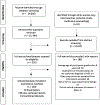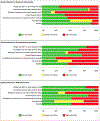Project AIM: Autism intervention meta-analysis for studies of young children
- PMID: 31763860
- PMCID: PMC8783568
- DOI: 10.1037/bul0000215
Project AIM: Autism intervention meta-analysis for studies of young children
Abstract
In this comprehensive systematic review and meta-analysis of group design studies of nonpharmacological early interventions designed for young children with autism spectrum disorder (ASD), we report summary effects across 7 early intervention types (behavioral, developmental, naturalistic developmental behavioral intervention [NDBI], TEACCH, sensory-based, animal-assisted, and technology-based), and 15 outcome categories indexing core and related ASD symptoms. A total of 1,615 effect sizes were gathered from 130 independent participant samples. A total of 6,240 participants, who ranged in age from 0-8 years, are represented across the studies. We synthesized effects within intervention and outcome type using a robust variance estimation approach to account for the nesting of effect sizes within studies. We also tracked study quality indicators, and report an additional set of summary effect sizes that restrict included studies to those meeting prespecified quality indicators. Finally, we conducted moderator analyses to evaluate whether summary effects across intervention types were larger for proximal as compared with distal effects, and for context-bound as compared to generalized effects. We found that when study quality indicators were not taken into account, significant positive effects were found for behavioral, developmental, and NDBI intervention types. When effect size estimation was limited to studies with randomized controlled trial (RCT) designs, evidence of positive summary effects existed only for developmental and NDBI intervention types. This was also the case when outcomes measured by parent report were excluded. Finally, when effect estimation was limited to RCT designs and to outcomes for which there was no risk of detection bias, no intervention types showed significant effects on any outcome. (PsycINFO Database Record (c) 2019 APA, all rights reserved).
Figures









References
-
- Aldred C, Green J, & Adams C (2004). A new social communication intervention for children with autism: Pilot randomised controlled treatment study suggesting effectiveness. Journal of Child Psychology and Psychiatry, 45, 1420–1430. - PubMed
-
- American Psychological Association (2013). Diagnostic and statistical manual of mental disorders (5th ed.). Arlington, VA: Author.
-
- Autism and insurance coverage; state laws. (2018). Retrieved from http://www.ncsl.org/research/health/autism-and-insurance-coverage-state-...
-
- Ayres AJ (1979). Sensory integration and the child. Los Angeles, CA: Western Psychological Services.
Publication types
MeSH terms
Grants and funding
LinkOut - more resources
Full Text Sources
Other Literature Sources
Medical

